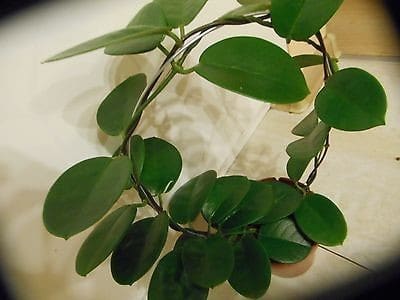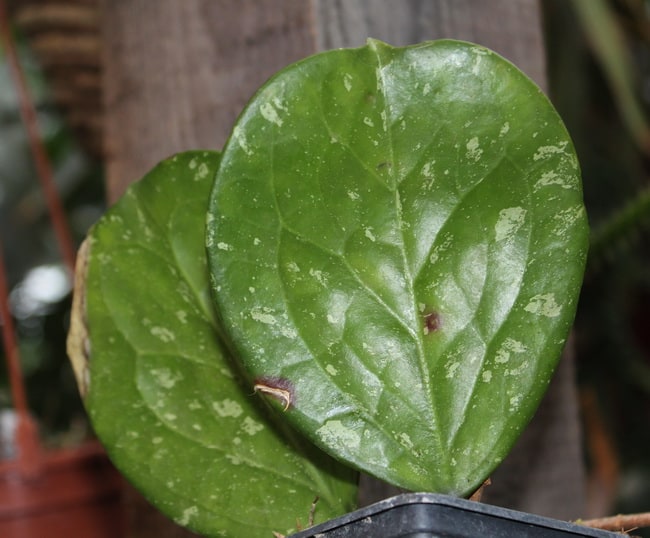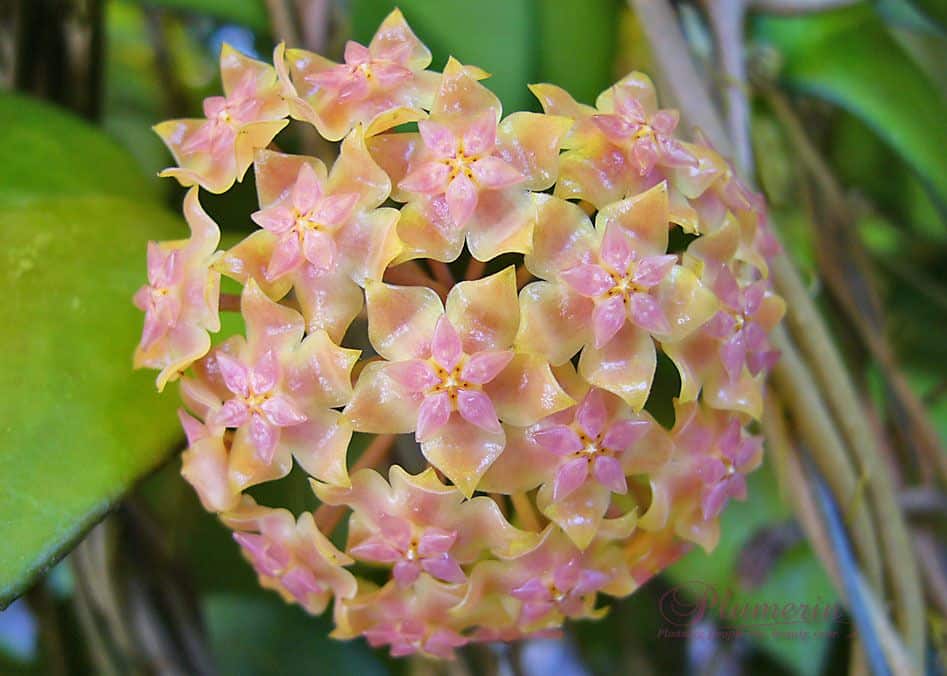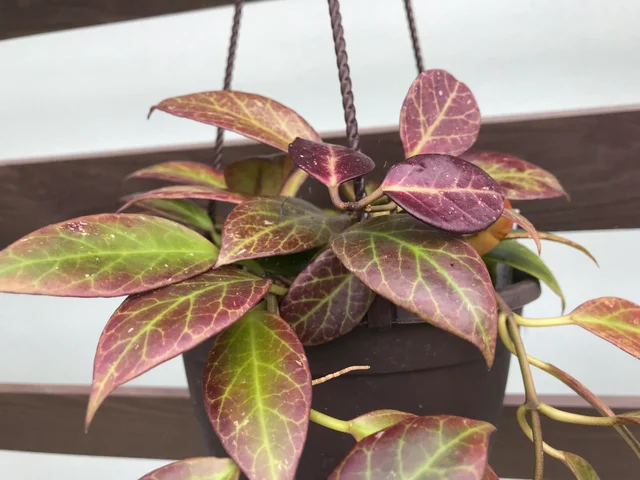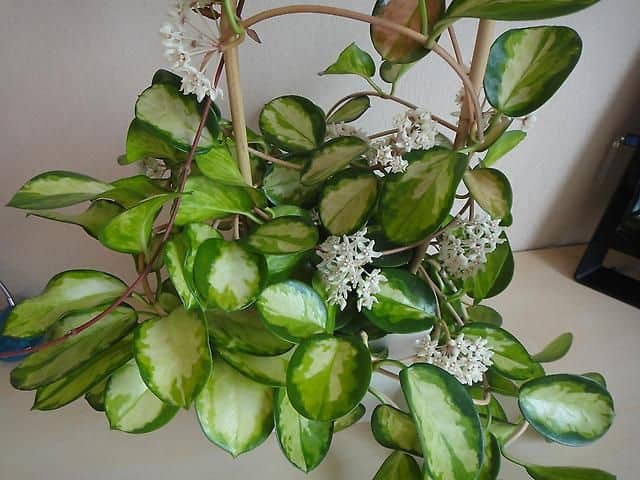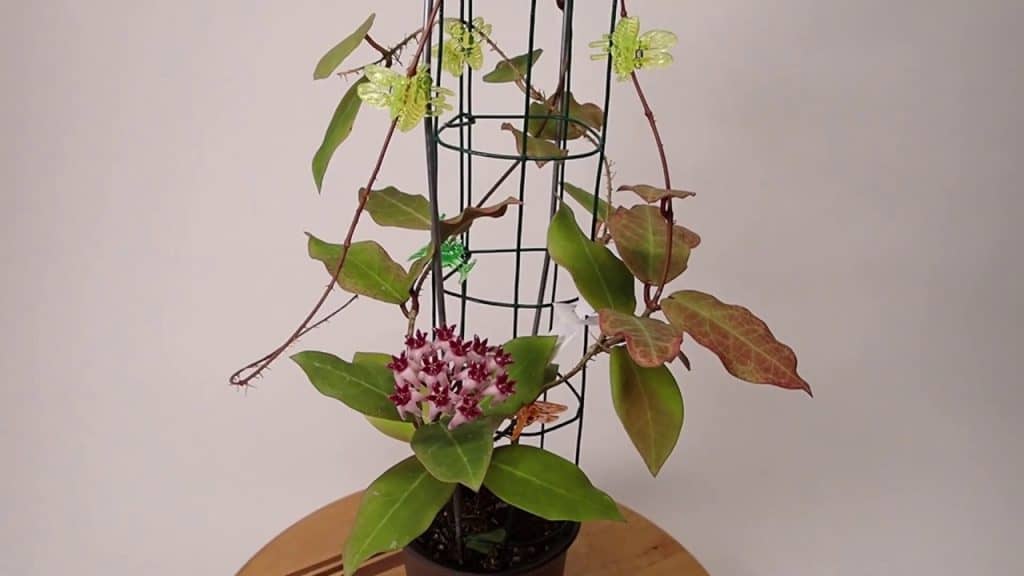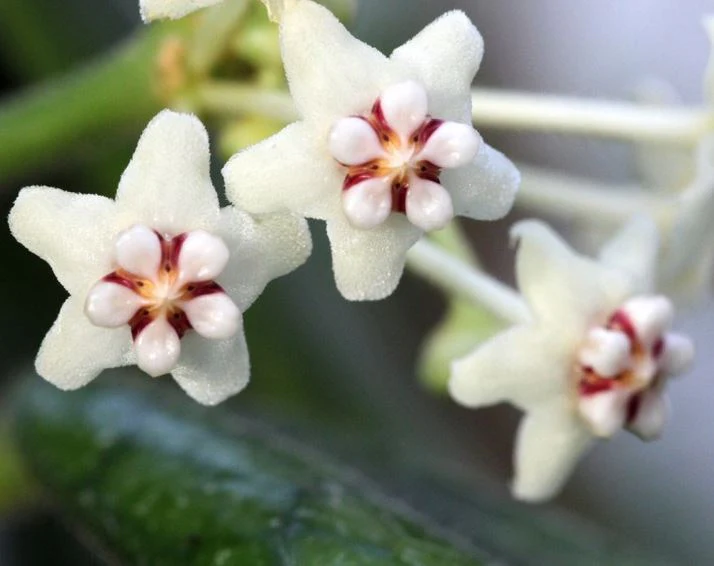Hoya keysii, also called a wax plant or waxflower, is not just one of the many house plants that can be grown in pots and brought inside during the winter months, but it’s also one of the most ornamental types of flowering plants that can grow to be quite large outdoors in U.S. Department of Agriculture hardiness zones 10 and 11.
Whether you bring this hoya inside or keep it outdoors year-round, there are several things you can do to help prevent common hoya keysii plant care problems and to help it reach its full potential as a flowering houseplant or an outdoor tropical plant.
If you’re looking to add a bit of tropical style to your home, you might be considering purchasing a hoya plant. These plants are known for their distinctive flowers and round, leafy leaves, and they come in several varieties with different flower shapes and colors.
Hoya keysii, also known as the wax plant or waxflower hoya, is one of the most popular types of hoya to grow indoors, due to its delicate, fragrant flowers that are attractive to many pollinators and easy-to-grow nature.
Origin and distribution
The Hoya keysii is native to an area of eastern Asia that includes China, Taiwan, and India. It also has a limited distribution in northern Australia. There are approximately 50 species of Hoyas; all are members of the plant family Apocynaceae, which contains over 1,000 species found primarily in tropical regions around the world.
All members of Apocynaceae have milky sap with toxic properties; although some members are more toxic than others, it’s wise to exercise caution when handling any member of Apocynaceae.
For example, if you receive a cut while handling your Hoya keysii plant, you should wash your hands thoroughly before eating or drinking anything, even water. A few drops of sap can cause severe discomfort for hours.
Hoya keysii propagation
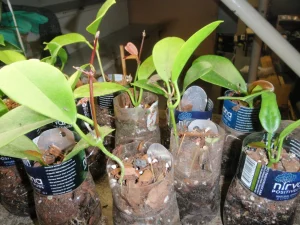
You can propagate a hoya keysii plant by taking stem cuttings or by dividing them. You can use rooting hormone on your stem cuttings, but you won’t need it if you take the division method. Either way, you’ll want to put your new plant into a pot that drains well and place it in bright but indirect light.
Water regularly until established, then maintain water levels evenly throughout spring and summer to encourage blooming.
If you want to divide up your hoya keysii plant, you should do so while they are still dormant. This is easy to do: simply remove all of their leaves and prune back any stems you don’t like. Divide up any large clumps using clean shears or scissors.
The most common propagation technique used for Hoya plants is division. This can be done at any time during their growing season, as long as you have taken care not to damage any of their roots.
The easiest way to accomplish division is to dig up your Hoya and gently pull apart each individual rosette, trying not to separate any of its roots from each other too much.
Hoya keysii care information
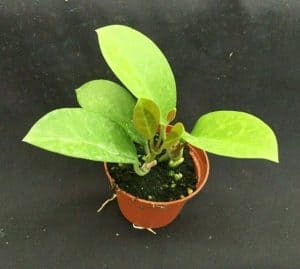
Hoya keysii, also known as the crown of thorns or Hawaiian name hapaluwawa, is a plant with shiny green leaves and white flowers. This plant requires medium-to-high indirect light and can be propagated by division and cuttings.
Hoya keysii requires very little water and fertilizer. Too much humidity can damage your plant so make sure to place it in a well-ventilated area. Overall, growing hoyas indoors is simple if you follow proper care guidelines!
Light requirement
Hoya keysii is a shade-loving plant that requires at least partial shade throughout its life. It grows best when placed in an area with filtered sun. If it receives direct sunlight for too long, its leaves will turn yellow and fall off.
When you want to get your hoya keysii to bloom, you should move it into full sunlight. Keep it there until buds form on each stem. Then move it back into partial shade and watch as your plant blooms beautifully!
If you live in a place where there are periods of extended sunlight, keep your Hoyas outside (but still protected from direct sunlight). Otherwise, place them near a window where they’ll get plenty of indirect light.
Soil/potting mix
The Hoya is a tropical plant that grows in very humid conditions, so you should use a mixture with equal parts of potting soil and perlite. Perlite is an inert, lightweight material used as an alternative to peat moss. It will retain water but also allow for good drainage.
The mix should be well-draining but not overly dry; always check on your plants every other day to see if they need more water or humidity. A large indoor container (for example, a large pot) filled with high-quality soil/potting mix and lined with plastic sheeting is needed to grow these plants indoors.
Watering
The best time to water your Hoyas is early in the morning so they have all day to dry out and avoid developing root rot. They should be watered lightly, never over-watered, and always use room temperature or warm water (never hot). They should also be allowed to drain thoroughly after watering.
To ensure a proper environment for healthy growth, we recommend that you use bottled spring water or filtered tap water when watering plants. For houseplants, do not use softened tap water as it may contain chemicals that can harm your plants.
Water should always be applied directly to soil –never onto leaves– to prevent leaf burn and stem damage caused by salt deposits on leaf surfaces.
Fertilizer
Homeowners should use a balanced fertilizer at planting time, and after two months of growth, they should switch to a fertilizer low in nitrogen. Nitrogen promotes leafy growth at the expense of flowers, so if you don’t want your Hoya Keysii plant to become all leaves and no flowers, avoid fertilizer with high levels of nitrogen.
For instance, look for fertilizers that are labeled as slow-release or low-nitrogen. The nutrients will be released over an extended period of time, allowing them to be taken up by roots slowly over several weeks instead of all at once.
This is important because too much nitrogen can burn roots. Using slow-release fertilizer also gives plants more flexibility when it comes to watering frequency; some people like to water their plants every day while others prefer a less frequent schedule.
Temperature
Hoya keysii thrives in conditions that replicate their natural environment. Daytime temperatures should be warm, around 75 to 85 degrees F, and night temperatures are best kept between 60 and 70 degrees F.
Humidity
As with many tropical plants, humidity is a must for hoyas. Mist your plant daily with lukewarm water for best results.
A hoya plant lives in tropical areas. Because of that, it needs humid air to grow. It’s not a good idea to put your plant in a room with an extremely dry atmosphere. Instead, keep your plant somewhere that has higher humidity levels than most rooms, such as a bathroom or kitchen with running water.
That said, you want to avoid letting moisture build up around your plant, so don’t put it near dripping faucets or plants that release extra moisture into the air.
The ideal humidity range for a hoya plant is between 40 and 60 percent. If you can’t measure your room’s relative humidity, don’t worry; just make sure you keep your plant away from drier areas of your home.
You can also mist your plant occasionally to help increase its water content. Be careful not to over-water, though; too much moisture can cause root rot and other problems.
Pruning
Hoya keysii plants are relatively easy to care for; however, they do require a bit of regular pruning. You can trim away flowers that have begun to wilt or die, and cutting out these dying blossoms will ensure your plant spends more energy on other blooms, not to mention you won’t have to deal with any annoying rotting.
There is one caveat: don’t prune back your Hoya too hard! If you cut it down too far, it may never recover. It’s better to err on the side of caution when it comes to pruning so as not to accidentally kill your precious little plant.
When to repot
As a rule of thumb, it’s safe to repot Hoya keysii once every three years or so. However, if you want to keep your plant healthy and in good shape, it’s advisable to repot more frequently—around once a year. Your plant will require more frequent repotting as it ages.
Dormancy
The Hoya plant tends to go dormant in cold weather. It stops growing and produces no leaves during dormancy, but continues to produce roots. Hoya plants are tropical plants, which means they don’t handle cold well at all.
During dormancy, your hoya should be kept as warm as possible without actually sitting in water.
During the winter months, if you live in a colder climate or if your home is especially drafty, you may want to consider moving your hoya into an area that stays warmer. If you have a sunroom or greenhouse with enough light and warmth for it to grow year-round, that would be ideal.
Flowers & fragrance
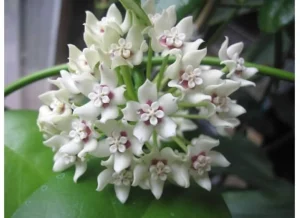
The Hoya keysii plant produces bell-shaped flowers that can be either yellow or white in color. The fragrant flowers are usually produced during spring and summer. They have an exotic scent, which is sweet and resembles jasmine. To help promote flowering in your plant, it should be exposed to direct sunlight for at least 10 hours a day throughout winter.
Growth rate
The growth rate of hoya keysii is slow but steady and reaches maturity at three to four years of age. Once it’s mature, it will grow a stem that is eight to 10 inches tall and six to eight leaves that are up to three inches long by one inch wide.
Although you can prune your plant’s stems as they get too tall or out of control, you shouldn’t have to do so more than once every year or two.
Toxicity
The leaves of Hoya keysii contain toxic substances, and ingestion of parts of any plant can cause vomiting. Do not put any part of a plant in your mouth, and keep all parts out of reach from children and pets.
USDA Hardiness Zones
Hoya keysii thrives best in USDA hardiness zones 10 and 11. In colder areas, it’s a good idea to grow your hoya indoors or in a greenhouse. It can be grown outdoors as an annual in these regions, but you’ll need to bring it inside during the winter months.
Pests and diseases
Hoyas are resistant to many pests and diseases, but they can still fall prey to aphids, mealybugs, scale, and leafhoppers. They can also attract ants with their sweet nectar. However, if you keep a watchful eye out for these pests and diseases, you’ll be able to handle any attacks before they cause serious damage.
